Comparative Analysis of Agricultural Subsidy Programs: China & India
VerifiedAdded on 2023/01/19
|19
|4746
|66
Report
AI Summary
This report provides a detailed comparative analysis of agricultural subsidy programs in China and India. It begins with an executive summary highlighting the shift in China's policy from taxation to subsidies for farmers, and the lack of household-level surveys to assess the program's impact. The report then delves into case studies of both countries, examining the rationale behind agricultural subsidies and the different approaches taken. In India's case, the report discusses the input subsidies and their unsustainability, advocating for institutional and price reforms. The Chinese case study explores the multi-step implementation of subsidy policies, from the central government to the local level, and the mechanisms for transferring funds to households. The negative impacts of input subsidies are also discussed, including cropping pattern effects, environmental concerns, fiscal effects, and equity issues. The report includes data analysis, such as tables illustrating subsidy awareness and fiscal impacts, and concludes with a summary of key findings. The report underscores the need for a balanced approach to agricultural subsidies to ensure their effectiveness and minimize negative consequences.
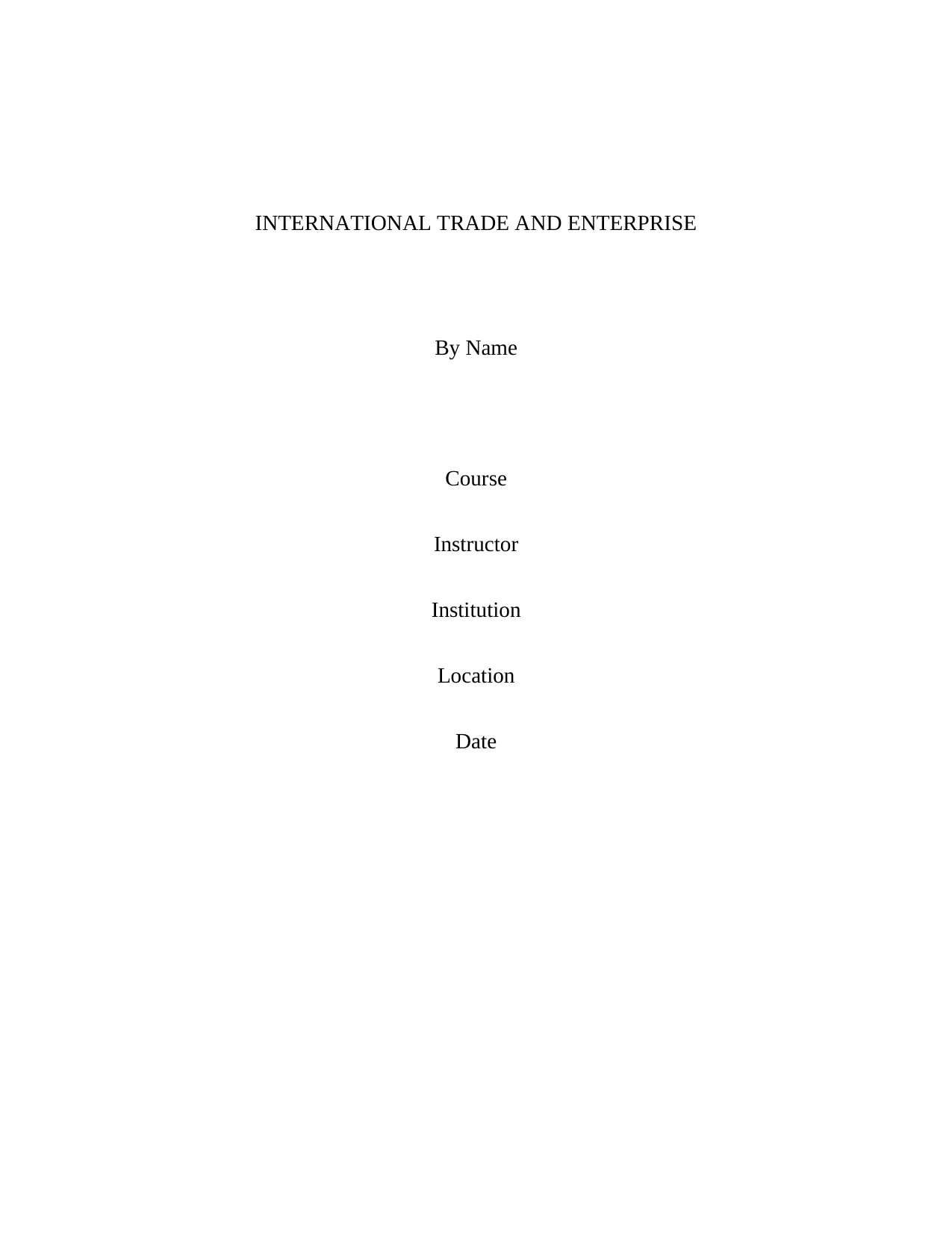
INTERNATIONAL TRADE AND ENTERPRISE
By Name
Course
Instructor
Institution
Location
Date
By Name
Course
Instructor
Institution
Location
Date
Paraphrase This Document
Need a fresh take? Get an instant paraphrase of this document with our AI Paraphraser
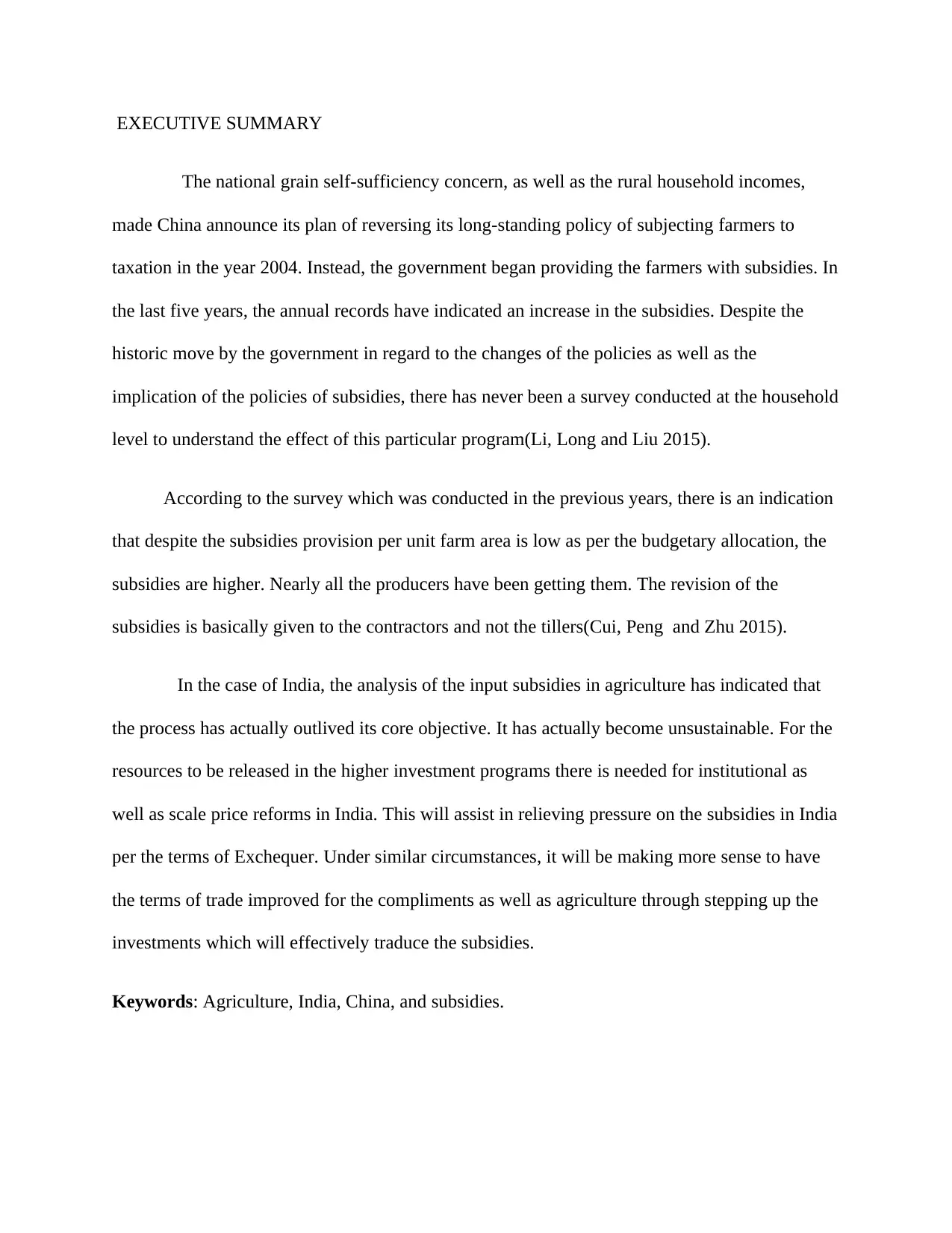
EXECUTIVE SUMMARY
The national grain self-sufficiency concern, as well as the rural household incomes,
made China announce its plan of reversing its long-standing policy of subjecting farmers to
taxation in the year 2004. Instead, the government began providing the farmers with subsidies. In
the last five years, the annual records have indicated an increase in the subsidies. Despite the
historic move by the government in regard to the changes of the policies as well as the
implication of the policies of subsidies, there has never been a survey conducted at the household
level to understand the effect of this particular program(Li, Long and Liu 2015).
According to the survey which was conducted in the previous years, there is an indication
that despite the subsidies provision per unit farm area is low as per the budgetary allocation, the
subsidies are higher. Nearly all the producers have been getting them. The revision of the
subsidies is basically given to the contractors and not the tillers(Cui, Peng and Zhu 2015).
In the case of India, the analysis of the input subsidies in agriculture has indicated that
the process has actually outlived its core objective. It has actually become unsustainable. For the
resources to be released in the higher investment programs there is needed for institutional as
well as scale price reforms in India. This will assist in relieving pressure on the subsidies in India
per the terms of Exchequer. Under similar circumstances, it will be making more sense to have
the terms of trade improved for the compliments as well as agriculture through stepping up the
investments which will effectively traduce the subsidies.
Keywords: Agriculture, India, China, and subsidies.
The national grain self-sufficiency concern, as well as the rural household incomes,
made China announce its plan of reversing its long-standing policy of subjecting farmers to
taxation in the year 2004. Instead, the government began providing the farmers with subsidies. In
the last five years, the annual records have indicated an increase in the subsidies. Despite the
historic move by the government in regard to the changes of the policies as well as the
implication of the policies of subsidies, there has never been a survey conducted at the household
level to understand the effect of this particular program(Li, Long and Liu 2015).
According to the survey which was conducted in the previous years, there is an indication
that despite the subsidies provision per unit farm area is low as per the budgetary allocation, the
subsidies are higher. Nearly all the producers have been getting them. The revision of the
subsidies is basically given to the contractors and not the tillers(Cui, Peng and Zhu 2015).
In the case of India, the analysis of the input subsidies in agriculture has indicated that
the process has actually outlived its core objective. It has actually become unsustainable. For the
resources to be released in the higher investment programs there is needed for institutional as
well as scale price reforms in India. This will assist in relieving pressure on the subsidies in India
per the terms of Exchequer. Under similar circumstances, it will be making more sense to have
the terms of trade improved for the compliments as well as agriculture through stepping up the
investments which will effectively traduce the subsidies.
Keywords: Agriculture, India, China, and subsidies.

Introduction
It has been reported widely by observers in about the subject of discontent of the rural
population in China as a result of the heavy taxes and fees prior to the year 2000. The leaders of
the village were expected by the government to facilitate the processes of financing their village
operation budgets as well as local public infrastructure with the fees assessed from the villagers.
The local government in various areas reacted through imposing very heavy taxes on the
farmers. In some cases, there was payment of more than 30% of the total annual earning by
households in the form of taxes and fees(Shaffer, Wolfe and Le 2015).
During this particular period, there was little transfer by the government as a way of
financial support to the rural economy. The entire amount of the subsidies which was being
targeted by the ministry of finance was just 10 million Yuan. This amount of money was actually
small considering the population of China's rural area. The subsidy that was given to agriculture
by the central government was less than 0.007 percent of the agricultural output value. This was
equivalent to 0.1 Yuan per capita. Most of these subsidies went to the local government as well
as enterprises and it is never clear whether farmers benefited from such programs(Latruffe et al
2017).
In India, the issue of subsidies in general and in particular agricultural subsidies have
assumed significant consideration. This has actually happened because of two major reasons.
One of such reasons is the rising burden of the revenue deficit that has been responsible for the
fiscal imbalance in the state as well as central budget in the late 1980s. The neglect of the simple
principles of the economy in the sector contributed their growth processes as well as their due.
It has been reported widely by observers in about the subject of discontent of the rural
population in China as a result of the heavy taxes and fees prior to the year 2000. The leaders of
the village were expected by the government to facilitate the processes of financing their village
operation budgets as well as local public infrastructure with the fees assessed from the villagers.
The local government in various areas reacted through imposing very heavy taxes on the
farmers. In some cases, there was payment of more than 30% of the total annual earning by
households in the form of taxes and fees(Shaffer, Wolfe and Le 2015).
During this particular period, there was little transfer by the government as a way of
financial support to the rural economy. The entire amount of the subsidies which was being
targeted by the ministry of finance was just 10 million Yuan. This amount of money was actually
small considering the population of China's rural area. The subsidy that was given to agriculture
by the central government was less than 0.007 percent of the agricultural output value. This was
equivalent to 0.1 Yuan per capita. Most of these subsidies went to the local government as well
as enterprises and it is never clear whether farmers benefited from such programs(Latruffe et al
2017).
In India, the issue of subsidies in general and in particular agricultural subsidies have
assumed significant consideration. This has actually happened because of two major reasons.
One of such reasons is the rising burden of the revenue deficit that has been responsible for the
fiscal imbalance in the state as well as central budget in the late 1980s. The neglect of the simple
principles of the economy in the sector contributed their growth processes as well as their due.
⊘ This is a preview!⊘
Do you want full access?
Subscribe today to unlock all pages.

Trusted by 1+ million students worldwide

These processes of the growth have relied on the foundation of the increasingly unsustainable
fiscal processes(Xu and Lin 2017).
The burgeoning difficulties of these subsidies have been questioned by the policy-making
authorities who are trying to have the fiscal imbalance corrected. Secondly, this particular issue
about the agricultural subsidies was brought to limelight under the GATT negotiation with
Uruguay. This resulted into a lot of misinformation as well as confusion, particularly in the
initial year of such process’s confusion, was about the establishment of whether Indian
agriculture was fully taxed or subsidized-determination of whether the aggregate support was
positive or negative.
The paper has been organized in various subheadings starting with the case studies of
agricultural subsidies in India, China before analyzing both the positive as well as negative
impacts of the program in these two countries. A conclusive remark is drawn as a summary of
the key points discussed in regard to the subject topic.
Indian case study
The agricultural subsidies are usually rationalized in the overall economic context to the
extent that they play a critical role in the development simulation of any state through the
increase reduction in agriculture, investment as well as employment. The subsidies in the
countries that are developing must be construed to be more instrumental in the promotion of the
risk-taking activities of the framers as opposed to anything else. The advancement of the
subsidies is meant to promote the use of transfer income or new inputs in favor of the community
that practices farming. This is done so as to keep them in parity with those other communities
that are non-agriculturalists.
fiscal processes(Xu and Lin 2017).
The burgeoning difficulties of these subsidies have been questioned by the policy-making
authorities who are trying to have the fiscal imbalance corrected. Secondly, this particular issue
about the agricultural subsidies was brought to limelight under the GATT negotiation with
Uruguay. This resulted into a lot of misinformation as well as confusion, particularly in the
initial year of such process’s confusion, was about the establishment of whether Indian
agriculture was fully taxed or subsidized-determination of whether the aggregate support was
positive or negative.
The paper has been organized in various subheadings starting with the case studies of
agricultural subsidies in India, China before analyzing both the positive as well as negative
impacts of the program in these two countries. A conclusive remark is drawn as a summary of
the key points discussed in regard to the subject topic.
Indian case study
The agricultural subsidies are usually rationalized in the overall economic context to the
extent that they play a critical role in the development simulation of any state through the
increase reduction in agriculture, investment as well as employment. The subsidies in the
countries that are developing must be construed to be more instrumental in the promotion of the
risk-taking activities of the framers as opposed to anything else. The advancement of the
subsidies is meant to promote the use of transfer income or new inputs in favor of the community
that practices farming. This is done so as to keep them in parity with those other communities
that are non-agriculturalists.
Paraphrase This Document
Need a fresh take? Get an instant paraphrase of this document with our AI Paraphraser
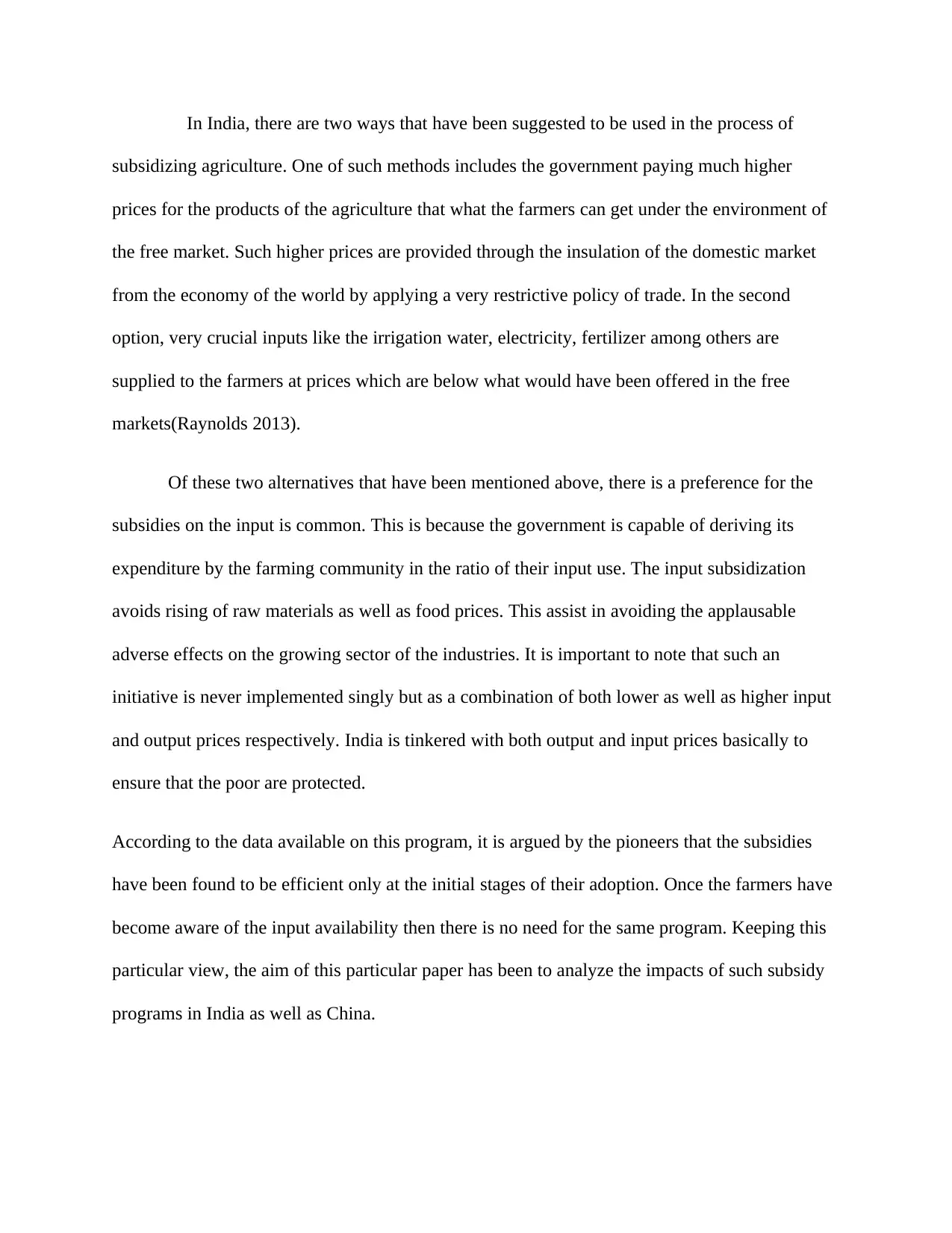
In India, there are two ways that have been suggested to be used in the process of
subsidizing agriculture. One of such methods includes the government paying much higher
prices for the products of the agriculture that what the farmers can get under the environment of
the free market. Such higher prices are provided through the insulation of the domestic market
from the economy of the world by applying a very restrictive policy of trade. In the second
option, very crucial inputs like the irrigation water, electricity, fertilizer among others are
supplied to the farmers at prices which are below what would have been offered in the free
markets(Raynolds 2013).
Of these two alternatives that have been mentioned above, there is a preference for the
subsidies on the input is common. This is because the government is capable of deriving its
expenditure by the farming community in the ratio of their input use. The input subsidization
avoids rising of raw materials as well as food prices. This assist in avoiding the applausable
adverse effects on the growing sector of the industries. It is important to note that such an
initiative is never implemented singly but as a combination of both lower as well as higher input
and output prices respectively. India is tinkered with both output and input prices basically to
ensure that the poor are protected.
According to the data available on this program, it is argued by the pioneers that the subsidies
have been found to be efficient only at the initial stages of their adoption. Once the farmers have
become aware of the input availability then there is no need for the same program. Keeping this
particular view, the aim of this particular paper has been to analyze the impacts of such subsidy
programs in India as well as China.
subsidizing agriculture. One of such methods includes the government paying much higher
prices for the products of the agriculture that what the farmers can get under the environment of
the free market. Such higher prices are provided through the insulation of the domestic market
from the economy of the world by applying a very restrictive policy of trade. In the second
option, very crucial inputs like the irrigation water, electricity, fertilizer among others are
supplied to the farmers at prices which are below what would have been offered in the free
markets(Raynolds 2013).
Of these two alternatives that have been mentioned above, there is a preference for the
subsidies on the input is common. This is because the government is capable of deriving its
expenditure by the farming community in the ratio of their input use. The input subsidization
avoids rising of raw materials as well as food prices. This assist in avoiding the applausable
adverse effects on the growing sector of the industries. It is important to note that such an
initiative is never implemented singly but as a combination of both lower as well as higher input
and output prices respectively. India is tinkered with both output and input prices basically to
ensure that the poor are protected.
According to the data available on this program, it is argued by the pioneers that the subsidies
have been found to be efficient only at the initial stages of their adoption. Once the farmers have
become aware of the input availability then there is no need for the same program. Keeping this
particular view, the aim of this particular paper has been to analyze the impacts of such subsidy
programs in India as well as China.
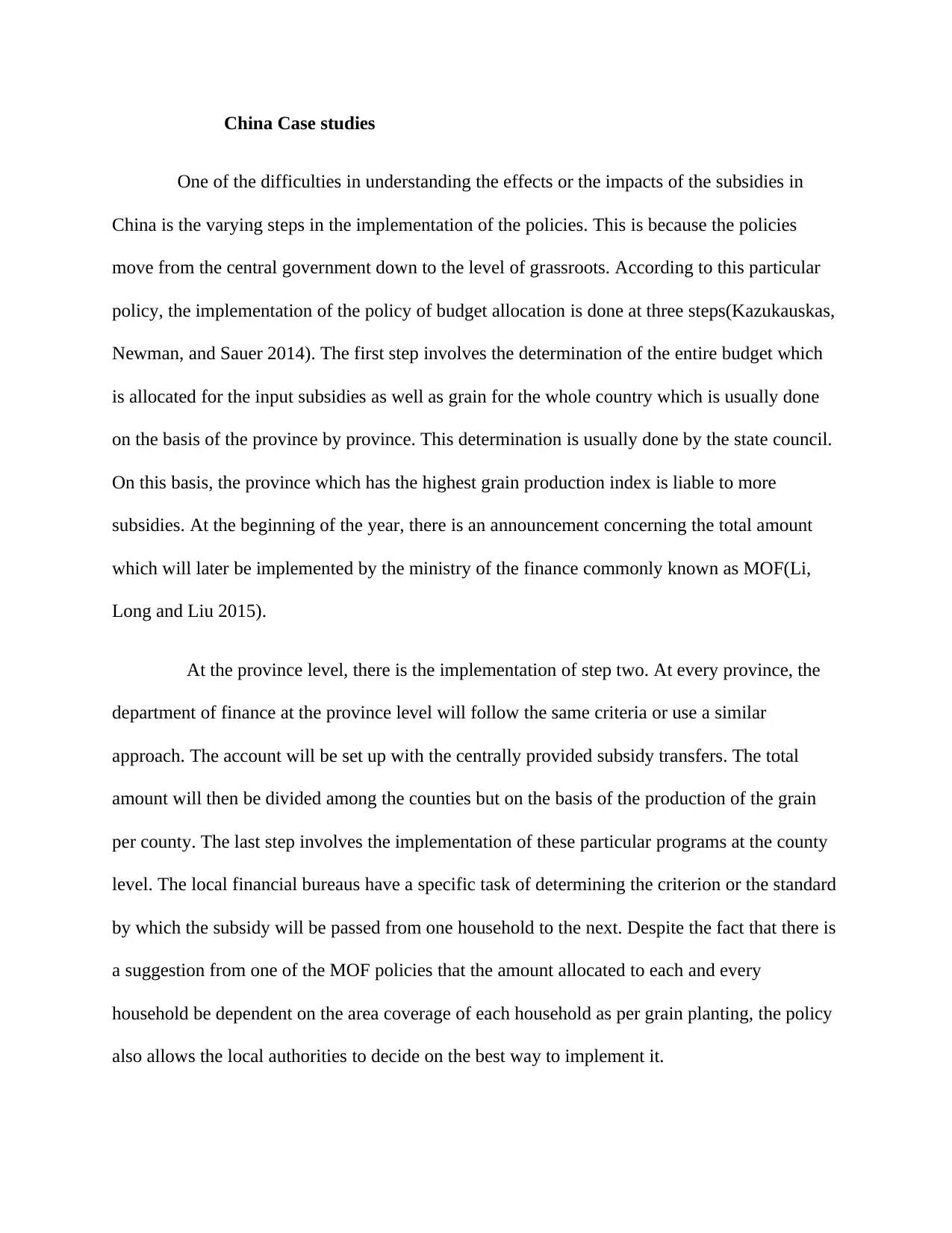
China Case studies
One of the difficulties in understanding the effects or the impacts of the subsidies in
China is the varying steps in the implementation of the policies. This is because the policies
move from the central government down to the level of grassroots. According to this particular
policy, the implementation of the policy of budget allocation is done at three steps(Kazukauskas,
Newman, and Sauer 2014). The first step involves the determination of the entire budget which
is allocated for the input subsidies as well as grain for the whole country which is usually done
on the basis of the province by province. This determination is usually done by the state council.
On this basis, the province which has the highest grain production index is liable to more
subsidies. At the beginning of the year, there is an announcement concerning the total amount
which will later be implemented by the ministry of the finance commonly known as MOF(Li,
Long and Liu 2015).
At the province level, there is the implementation of step two. At every province, the
department of finance at the province level will follow the same criteria or use a similar
approach. The account will be set up with the centrally provided subsidy transfers. The total
amount will then be divided among the counties but on the basis of the production of the grain
per county. The last step involves the implementation of these particular programs at the county
level. The local financial bureaus have a specific task of determining the criterion or the standard
by which the subsidy will be passed from one household to the next. Despite the fact that there is
a suggestion from one of the MOF policies that the amount allocated to each and every
household be dependent on the area coverage of each household as per grain planting, the policy
also allows the local authorities to decide on the best way to implement it.
One of the difficulties in understanding the effects or the impacts of the subsidies in
China is the varying steps in the implementation of the policies. This is because the policies
move from the central government down to the level of grassroots. According to this particular
policy, the implementation of the policy of budget allocation is done at three steps(Kazukauskas,
Newman, and Sauer 2014). The first step involves the determination of the entire budget which
is allocated for the input subsidies as well as grain for the whole country which is usually done
on the basis of the province by province. This determination is usually done by the state council.
On this basis, the province which has the highest grain production index is liable to more
subsidies. At the beginning of the year, there is an announcement concerning the total amount
which will later be implemented by the ministry of the finance commonly known as MOF(Li,
Long and Liu 2015).
At the province level, there is the implementation of step two. At every province, the
department of finance at the province level will follow the same criteria or use a similar
approach. The account will be set up with the centrally provided subsidy transfers. The total
amount will then be divided among the counties but on the basis of the production of the grain
per county. The last step involves the implementation of these particular programs at the county
level. The local financial bureaus have a specific task of determining the criterion or the standard
by which the subsidy will be passed from one household to the next. Despite the fact that there is
a suggestion from one of the MOF policies that the amount allocated to each and every
household be dependent on the area coverage of each household as per grain planting, the policy
also allows the local authorities to decide on the best way to implement it.
⊘ This is a preview!⊘
Do you want full access?
Subscribe today to unlock all pages.

Trusted by 1+ million students worldwide
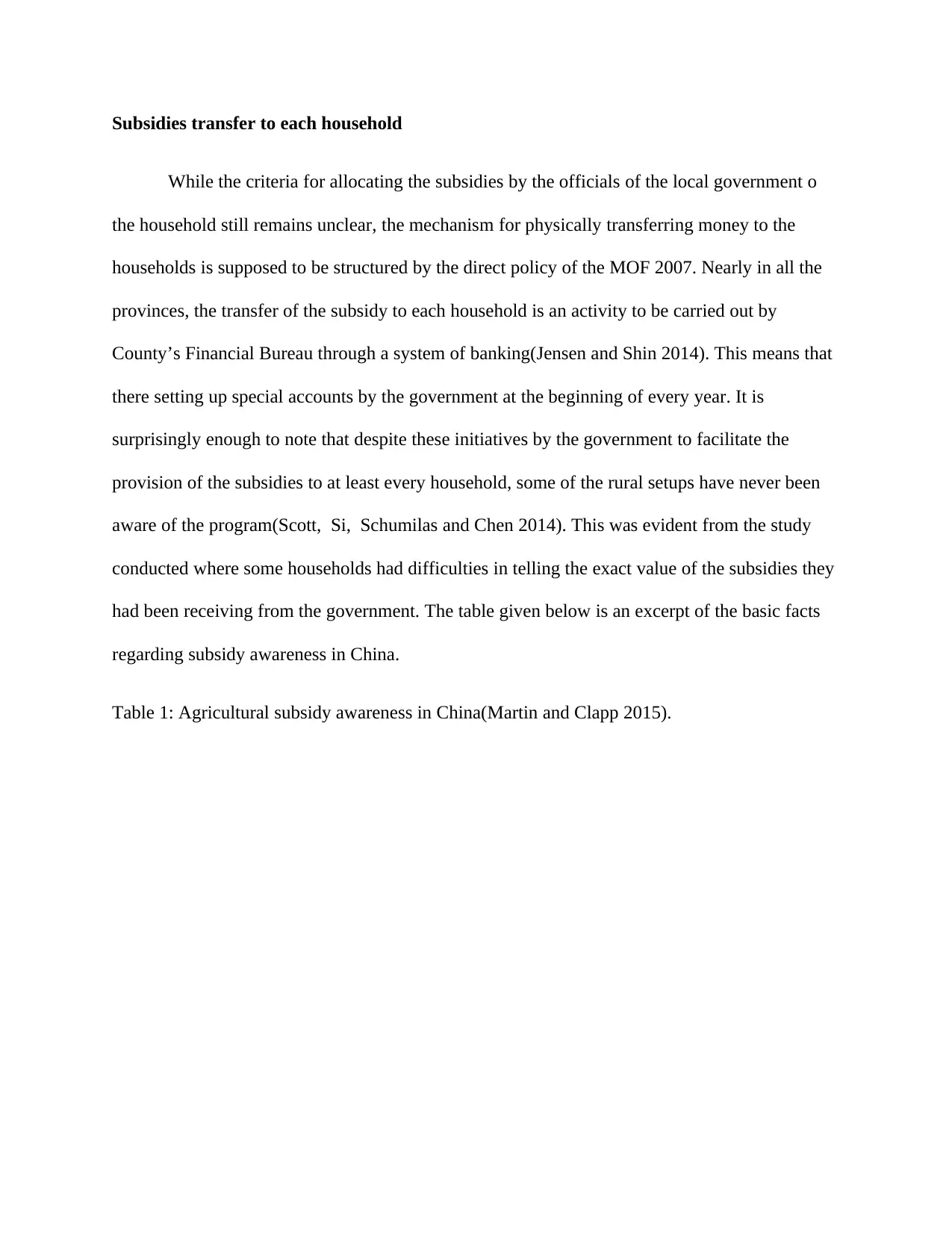
Subsidies transfer to each household
While the criteria for allocating the subsidies by the officials of the local government o
the household still remains unclear, the mechanism for physically transferring money to the
households is supposed to be structured by the direct policy of the MOF 2007. Nearly in all the
provinces, the transfer of the subsidy to each household is an activity to be carried out by
County’s Financial Bureau through a system of banking(Jensen and Shin 2014). This means that
there setting up special accounts by the government at the beginning of every year. It is
surprisingly enough to note that despite these initiatives by the government to facilitate the
provision of the subsidies to at least every household, some of the rural setups have never been
aware of the program(Scott, Si, Schumilas and Chen 2014). This was evident from the study
conducted where some households had difficulties in telling the exact value of the subsidies they
had been receiving from the government. The table given below is an excerpt of the basic facts
regarding subsidy awareness in China.
Table 1: Agricultural subsidy awareness in China(Martin and Clapp 2015).
While the criteria for allocating the subsidies by the officials of the local government o
the household still remains unclear, the mechanism for physically transferring money to the
households is supposed to be structured by the direct policy of the MOF 2007. Nearly in all the
provinces, the transfer of the subsidy to each household is an activity to be carried out by
County’s Financial Bureau through a system of banking(Jensen and Shin 2014). This means that
there setting up special accounts by the government at the beginning of every year. It is
surprisingly enough to note that despite these initiatives by the government to facilitate the
provision of the subsidies to at least every household, some of the rural setups have never been
aware of the program(Scott, Si, Schumilas and Chen 2014). This was evident from the study
conducted where some households had difficulties in telling the exact value of the subsidies they
had been receiving from the government. The table given below is an excerpt of the basic facts
regarding subsidy awareness in China.
Table 1: Agricultural subsidy awareness in China(Martin and Clapp 2015).
Paraphrase This Document
Need a fresh take? Get an instant paraphrase of this document with our AI Paraphraser

Negative Impact of input subsidies
Input subsidies have a lot of effects on the economy which can be categorized into cropping
pattern effect, environmental effect, fiscal effect, equity effect and effect on new industries or
technology as discussed below(Li, Banik, Tang and Wu 2014).
Direct Fiscal Effect
In the early 1980s, there was a rapid growth rate of input subsidies compared to the combined
plan expenditure on agriculture, special area programs incurred by the center and state
government and irrigation as pointed out by the high figures of various input subsidies in Indian
agriculture as shown in the table below(Gale 2015.)
Table 2: Summary of the subsidy activities in the Indian context(Martin and Clapp 2015)
Input subsidies have a lot of effects on the economy which can be categorized into cropping
pattern effect, environmental effect, fiscal effect, equity effect and effect on new industries or
technology as discussed below(Li, Banik, Tang and Wu 2014).
Direct Fiscal Effect
In the early 1980s, there was a rapid growth rate of input subsidies compared to the combined
plan expenditure on agriculture, special area programs incurred by the center and state
government and irrigation as pointed out by the high figures of various input subsidies in Indian
agriculture as shown in the table below(Gale 2015.)
Table 2: Summary of the subsidy activities in the Indian context(Martin and Clapp 2015)
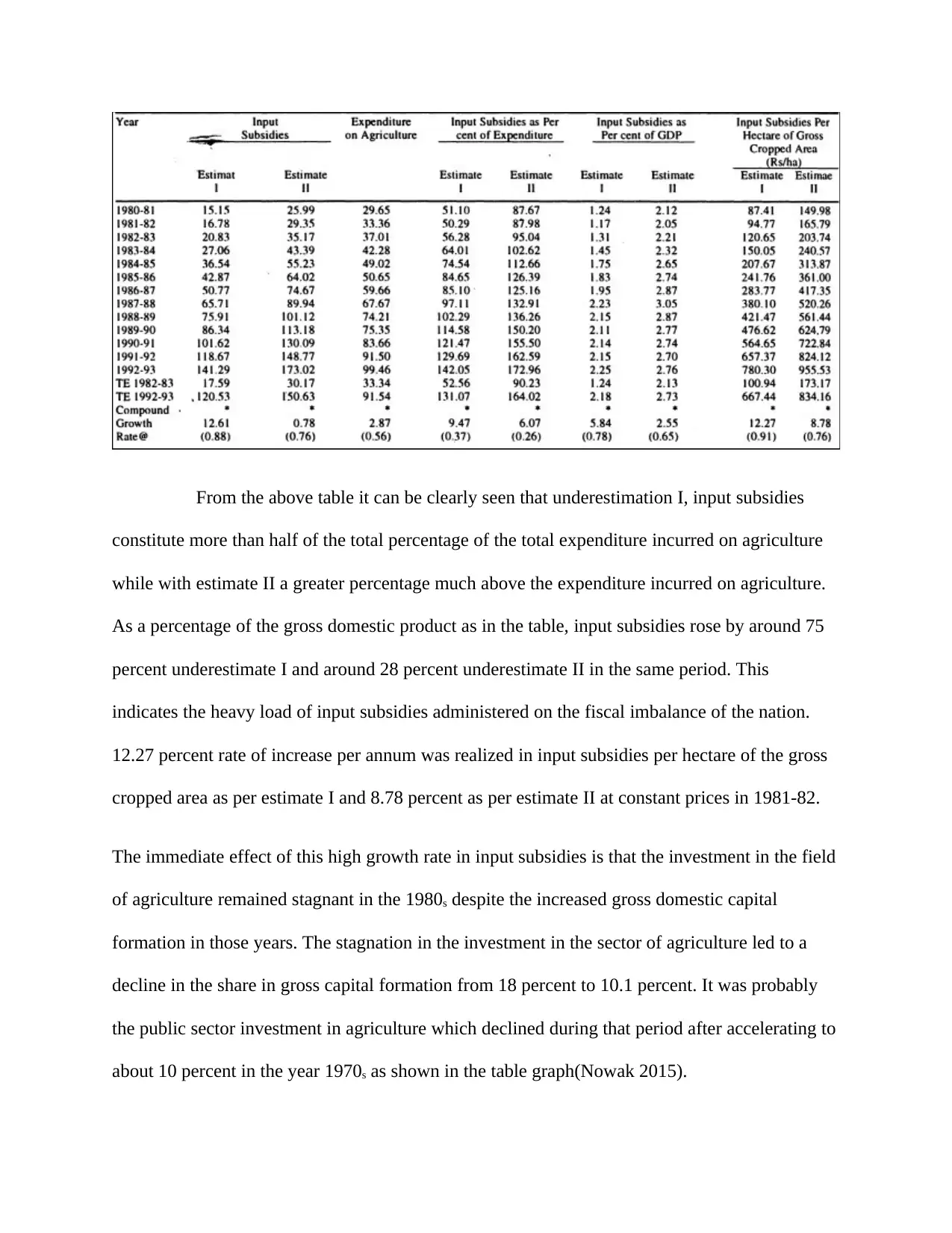
From the above table it can be clearly seen that underestimation I, input subsidies
constitute more than half of the total percentage of the total expenditure incurred on agriculture
while with estimate II a greater percentage much above the expenditure incurred on agriculture.
As a percentage of the gross domestic product as in the table, input subsidies rose by around 75
percent underestimate I and around 28 percent underestimate II in the same period. This
indicates the heavy load of input subsidies administered on the fiscal imbalance of the nation.
12.27 percent rate of increase per annum was realized in input subsidies per hectare of the gross
cropped area as per estimate I and 8.78 percent as per estimate II at constant prices in 1981-82.
The immediate effect of this high growth rate in input subsidies is that the investment in the field
of agriculture remained stagnant in the 1980s despite the increased gross domestic capital
formation in those years. The stagnation in the investment in the sector of agriculture led to a
decline in the share in gross capital formation from 18 percent to 10.1 percent. It was probably
the public sector investment in agriculture which declined during that period after accelerating to
about 10 percent in the year 1970s as shown in the table graph(Nowak 2015).
constitute more than half of the total percentage of the total expenditure incurred on agriculture
while with estimate II a greater percentage much above the expenditure incurred on agriculture.
As a percentage of the gross domestic product as in the table, input subsidies rose by around 75
percent underestimate I and around 28 percent underestimate II in the same period. This
indicates the heavy load of input subsidies administered on the fiscal imbalance of the nation.
12.27 percent rate of increase per annum was realized in input subsidies per hectare of the gross
cropped area as per estimate I and 8.78 percent as per estimate II at constant prices in 1981-82.
The immediate effect of this high growth rate in input subsidies is that the investment in the field
of agriculture remained stagnant in the 1980s despite the increased gross domestic capital
formation in those years. The stagnation in the investment in the sector of agriculture led to a
decline in the share in gross capital formation from 18 percent to 10.1 percent. It was probably
the public sector investment in agriculture which declined during that period after accelerating to
about 10 percent in the year 1970s as shown in the table graph(Nowak 2015).
⊘ This is a preview!⊘
Do you want full access?
Subscribe today to unlock all pages.

Trusted by 1+ million students worldwide

Figure 1: Graphical analysis of the subsidy program in India(Martin and Clapp 2015)
The stagnation in agricultural investment has still progressed to the current years, the 1990s. The
gross capital formation in agriculture has further declined with huge amounts.
Cropping Pattern Effect
Subsidized irrigation through canal water and electricity has caused deformation in the pattern of
crop growing by favoring water-intensive crops like sugarcane in Maharashtra and paddy in
Punjab. However, the flavor has resulted in increased production of sugarcane and paddy by a
greater percentage in India. Because of the high irrigation practice required by these crops, a
large amount of the scarce water and electricity available for agriculture is used resulting in high
subsidies on electricity and canal waters. Similar effects have been felt in China in various
provinces.
Environmental Effect
The stagnation in agricultural investment has still progressed to the current years, the 1990s. The
gross capital formation in agriculture has further declined with huge amounts.
Cropping Pattern Effect
Subsidized irrigation through canal water and electricity has caused deformation in the pattern of
crop growing by favoring water-intensive crops like sugarcane in Maharashtra and paddy in
Punjab. However, the flavor has resulted in increased production of sugarcane and paddy by a
greater percentage in India. Because of the high irrigation practice required by these crops, a
large amount of the scarce water and electricity available for agriculture is used resulting in high
subsidies on electricity and canal waters. Similar effects have been felt in China in various
provinces.
Environmental Effect
Paraphrase This Document
Need a fresh take? Get an instant paraphrase of this document with our AI Paraphraser
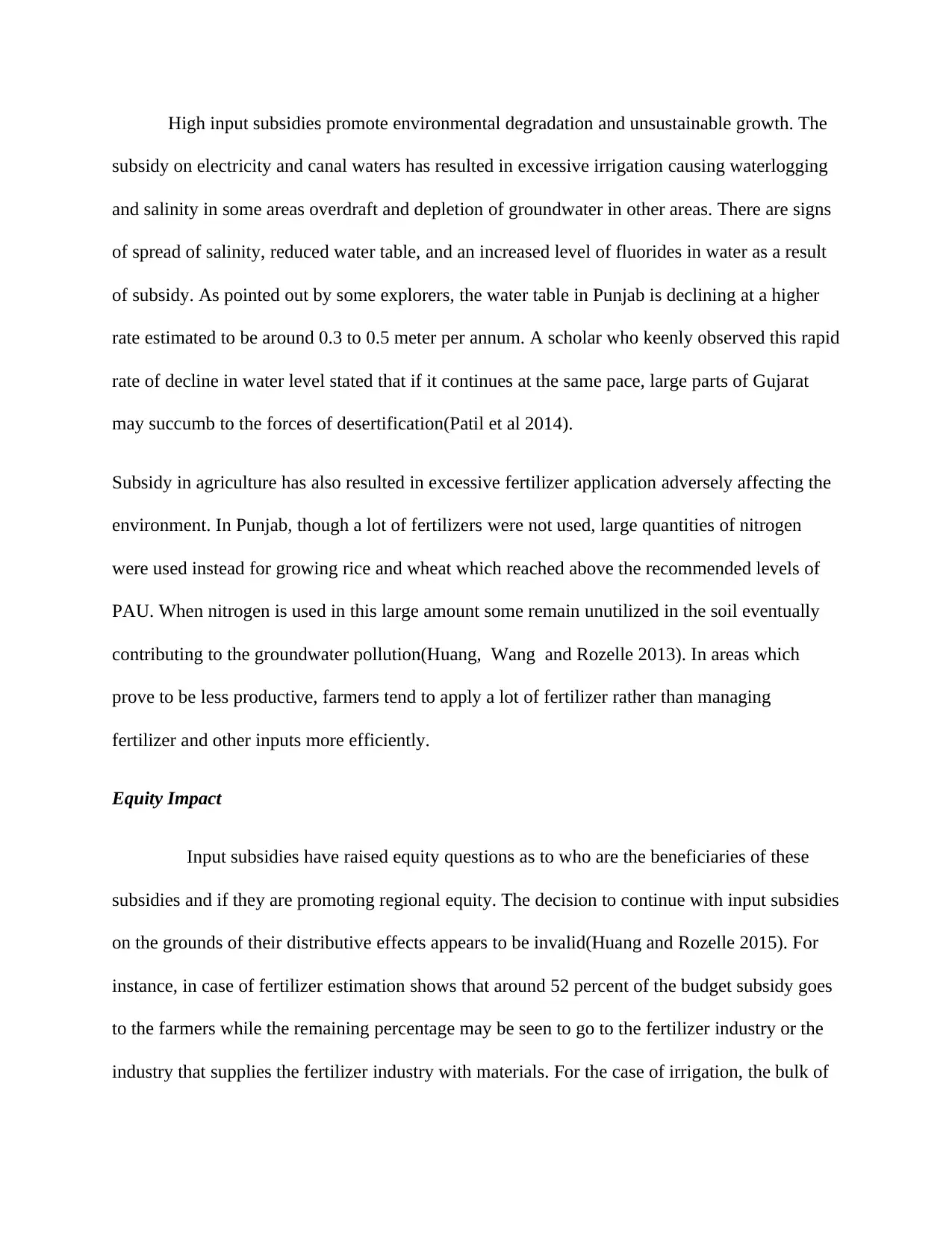
High input subsidies promote environmental degradation and unsustainable growth. The
subsidy on electricity and canal waters has resulted in excessive irrigation causing waterlogging
and salinity in some areas overdraft and depletion of groundwater in other areas. There are signs
of spread of salinity, reduced water table, and an increased level of fluorides in water as a result
of subsidy. As pointed out by some explorers, the water table in Punjab is declining at a higher
rate estimated to be around 0.3 to 0.5 meter per annum. A scholar who keenly observed this rapid
rate of decline in water level stated that if it continues at the same pace, large parts of Gujarat
may succumb to the forces of desertification(Patil et al 2014).
Subsidy in agriculture has also resulted in excessive fertilizer application adversely affecting the
environment. In Punjab, though a lot of fertilizers were not used, large quantities of nitrogen
were used instead for growing rice and wheat which reached above the recommended levels of
PAU. When nitrogen is used in this large amount some remain unutilized in the soil eventually
contributing to the groundwater pollution(Huang, Wang and Rozelle 2013). In areas which
prove to be less productive, farmers tend to apply a lot of fertilizer rather than managing
fertilizer and other inputs more efficiently.
Equity Impact
Input subsidies have raised equity questions as to who are the beneficiaries of these
subsidies and if they are promoting regional equity. The decision to continue with input subsidies
on the grounds of their distributive effects appears to be invalid(Huang and Rozelle 2015). For
instance, in case of fertilizer estimation shows that around 52 percent of the budget subsidy goes
to the farmers while the remaining percentage may be seen to go to the fertilizer industry or the
industry that supplies the fertilizer industry with materials. For the case of irrigation, the bulk of
subsidy on electricity and canal waters has resulted in excessive irrigation causing waterlogging
and salinity in some areas overdraft and depletion of groundwater in other areas. There are signs
of spread of salinity, reduced water table, and an increased level of fluorides in water as a result
of subsidy. As pointed out by some explorers, the water table in Punjab is declining at a higher
rate estimated to be around 0.3 to 0.5 meter per annum. A scholar who keenly observed this rapid
rate of decline in water level stated that if it continues at the same pace, large parts of Gujarat
may succumb to the forces of desertification(Patil et al 2014).
Subsidy in agriculture has also resulted in excessive fertilizer application adversely affecting the
environment. In Punjab, though a lot of fertilizers were not used, large quantities of nitrogen
were used instead for growing rice and wheat which reached above the recommended levels of
PAU. When nitrogen is used in this large amount some remain unutilized in the soil eventually
contributing to the groundwater pollution(Huang, Wang and Rozelle 2013). In areas which
prove to be less productive, farmers tend to apply a lot of fertilizer rather than managing
fertilizer and other inputs more efficiently.
Equity Impact
Input subsidies have raised equity questions as to who are the beneficiaries of these
subsidies and if they are promoting regional equity. The decision to continue with input subsidies
on the grounds of their distributive effects appears to be invalid(Huang and Rozelle 2015). For
instance, in case of fertilizer estimation shows that around 52 percent of the budget subsidy goes
to the farmers while the remaining percentage may be seen to go to the fertilizer industry or the
industry that supplies the fertilizer industry with materials. For the case of irrigation, the bulk of
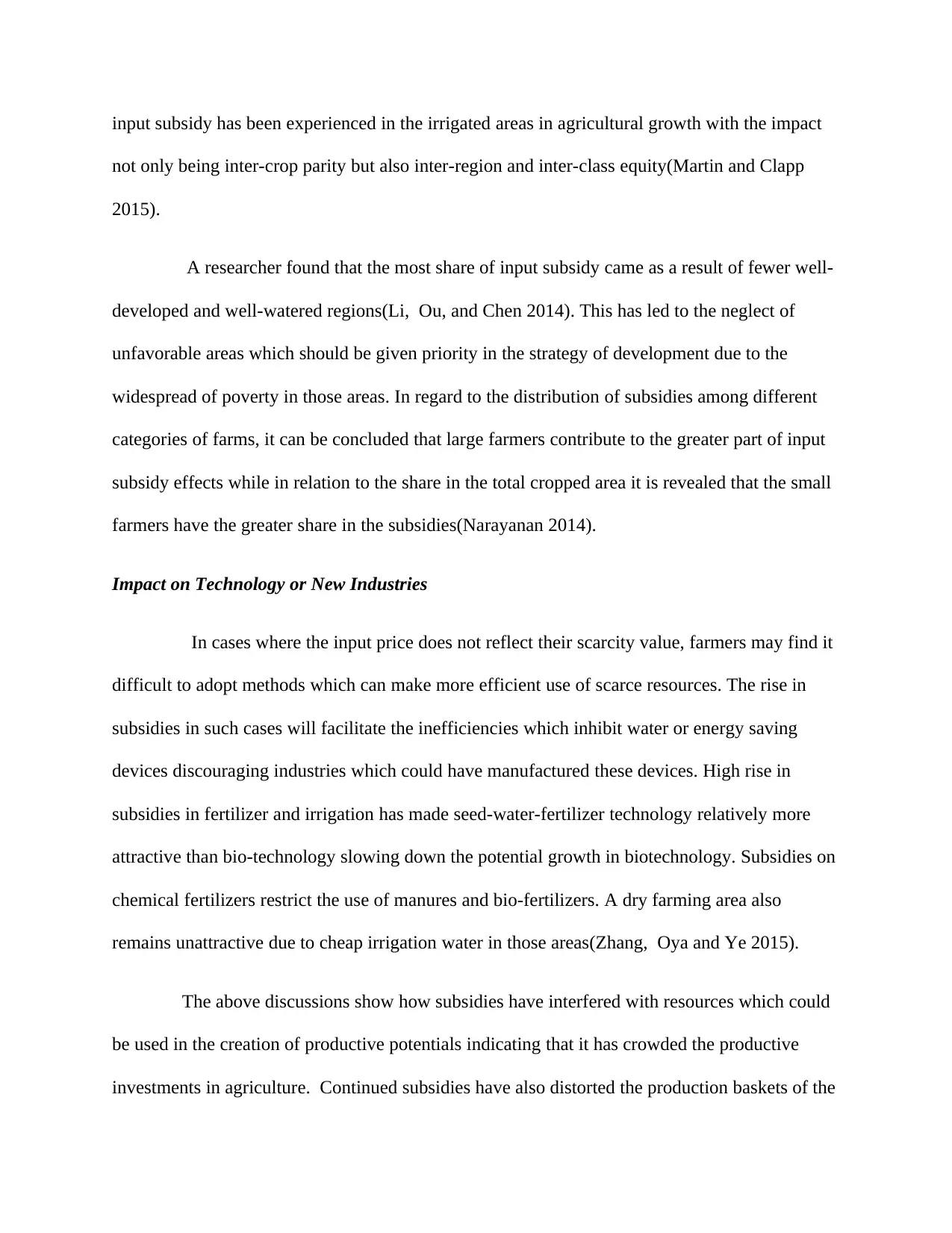
input subsidy has been experienced in the irrigated areas in agricultural growth with the impact
not only being inter-crop parity but also inter-region and inter-class equity(Martin and Clapp
2015).
A researcher found that the most share of input subsidy came as a result of fewer well-
developed and well-watered regions(Li, Ou, and Chen 2014). This has led to the neglect of
unfavorable areas which should be given priority in the strategy of development due to the
widespread of poverty in those areas. In regard to the distribution of subsidies among different
categories of farms, it can be concluded that large farmers contribute to the greater part of input
subsidy effects while in relation to the share in the total cropped area it is revealed that the small
farmers have the greater share in the subsidies(Narayanan 2014).
Impact on Technology or New Industries
In cases where the input price does not reflect their scarcity value, farmers may find it
difficult to adopt methods which can make more efficient use of scarce resources. The rise in
subsidies in such cases will facilitate the inefficiencies which inhibit water or energy saving
devices discouraging industries which could have manufactured these devices. High rise in
subsidies in fertilizer and irrigation has made seed-water-fertilizer technology relatively more
attractive than bio-technology slowing down the potential growth in biotechnology. Subsidies on
chemical fertilizers restrict the use of manures and bio-fertilizers. A dry farming area also
remains unattractive due to cheap irrigation water in those areas(Zhang, Oya and Ye 2015).
The above discussions show how subsidies have interfered with resources which could
be used in the creation of productive potentials indicating that it has crowded the productive
investments in agriculture. Continued subsidies have also distorted the production baskets of the
not only being inter-crop parity but also inter-region and inter-class equity(Martin and Clapp
2015).
A researcher found that the most share of input subsidy came as a result of fewer well-
developed and well-watered regions(Li, Ou, and Chen 2014). This has led to the neglect of
unfavorable areas which should be given priority in the strategy of development due to the
widespread of poverty in those areas. In regard to the distribution of subsidies among different
categories of farms, it can be concluded that large farmers contribute to the greater part of input
subsidy effects while in relation to the share in the total cropped area it is revealed that the small
farmers have the greater share in the subsidies(Narayanan 2014).
Impact on Technology or New Industries
In cases where the input price does not reflect their scarcity value, farmers may find it
difficult to adopt methods which can make more efficient use of scarce resources. The rise in
subsidies in such cases will facilitate the inefficiencies which inhibit water or energy saving
devices discouraging industries which could have manufactured these devices. High rise in
subsidies in fertilizer and irrigation has made seed-water-fertilizer technology relatively more
attractive than bio-technology slowing down the potential growth in biotechnology. Subsidies on
chemical fertilizers restrict the use of manures and bio-fertilizers. A dry farming area also
remains unattractive due to cheap irrigation water in those areas(Zhang, Oya and Ye 2015).
The above discussions show how subsidies have interfered with resources which could
be used in the creation of productive potentials indicating that it has crowded the productive
investments in agriculture. Continued subsidies have also distorted the production baskets of the
⊘ This is a preview!⊘
Do you want full access?
Subscribe today to unlock all pages.

Trusted by 1+ million students worldwide
1 out of 19
Your All-in-One AI-Powered Toolkit for Academic Success.
+13062052269
info@desklib.com
Available 24*7 on WhatsApp / Email
![[object Object]](/_next/static/media/star-bottom.7253800d.svg)
Unlock your academic potential
Copyright © 2020–2025 A2Z Services. All Rights Reserved. Developed and managed by ZUCOL.
